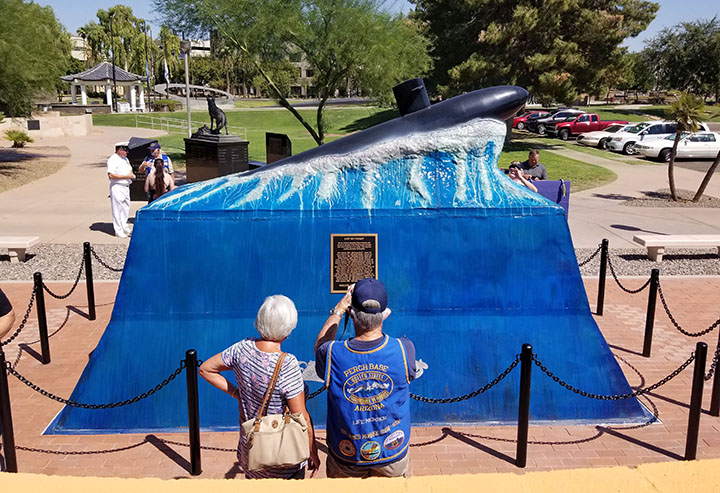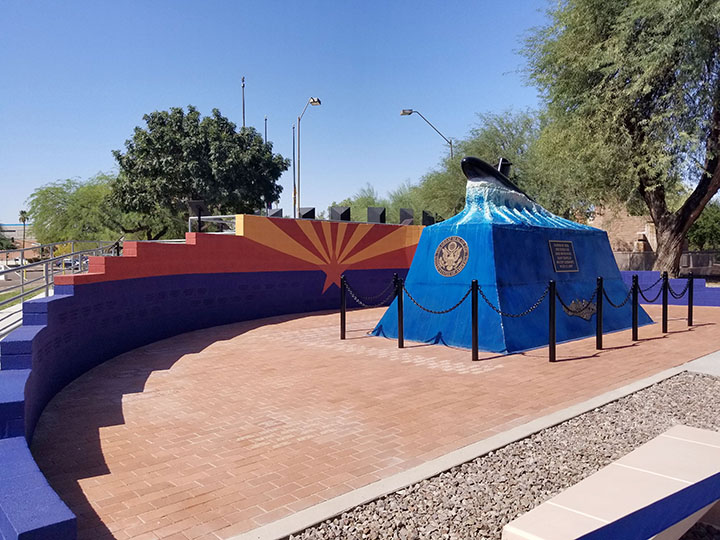Writer Joseph J. Airdo
Photography by Marion Cartland
[dropcap]T[/dropcap]he first time that Anthem resident Chris Urness saw the finished centerpiece of the new Arizona Silent Service Memorial, he experienced a flood of emotions that ranged from pride to satisfaction.
“It brought back a lot of memories of my time on submarines and all of the great friends, fun and camaraderie that we had while doing extremely top-secret, important, strategic missions for the United States,” says Urness, who served eight years in the United States Submarine Force. “It is really important to have a space for what we call ‘Brothers of the ‘Phin.’”
Submariners hold the term in exceptionally high regard as it refers to the dolphin pins that each of them wears on their uniform.
Urness currently co-chairs the Arizona Silent Service Memorial Foundation — a nonprofit organization that spearheaded the efforts to erect the monument at Wesley Bolin Memorial Plaza — with Marcus Hensley, who was stationed on seven different submarines over 23 years of service.
Hensley adds that it is important to honor the heritage and the legacy of the servicemen and women in the United States Submarine Force — both those who are currently serving and those who have lost their lives while doing so.
The Arizona Silent Service Memorial’s dedication plaque reads, “To perpetuate the memory of our shipmates who gave their lives in the pursuit of their duties while serving their country, and to honor those sailors who are serving our country beneath the world’s oceans today.”
A second plaque pays tribute to those submarine veterans who served and were from Arizona. Below a list of their names, ranks, submarines and hometowns, the plaque reads, “Sailors, rest your oars.”
Although Arizona Silent Service Memorial made its public debut Sept. 28, 2020, during a lei-cutting ceremony, a formal dedication ceremony for the 14-foot-long, 11-foot-tall monument is scheduled for Saturday, April 17 at Wesley Bolin Memorial Plaza.
Maneuvering Watch
The initiative to erect the Arizona Silent Service Memorial initially began as a notion to bring the sail of the nuclear submarine USS Phoenix to the Valley.
“That turned out to be prohibitive for a few reasons — a lot of them due to cost,” Hensley says.
Instead, the Arizona Silent Service Memorial Foundation was formed in 2013 and began floating around ideas that would honor submarine veterans — servicemen and women who rarely receive recognition for their tremendous sacrifices.
Urness says that submarine veterans are, by the nature of their work, stealthy and secret.
“What we do is not published in the papers or recognized by the media,” he explains, noting the importance of a site to honor past, present and future submariners and their families. “It is a place where the civilian population can also reflect upon their sacrifice and realize that there are a lot of people underwater hundreds of days out of the year with very little to no contact with the outside world who are never even thought about.”
In 2014, Arizona Silent Service Memorial Foundation members went before the Arizona State Senate, which then authorized the department of administration to provide for the placement in Wesley Bolin Memorial Plaza of a memorial dedicated to the commemoration of United States submarine veterans.
However, the Senate did not authorize public monies for the costs of the monument, instead stipulating that all fundraising and contracts for artistic design and construction of the memorial were the sole responsibility of the proponents. Therefore the Arizona Silent Service Memorial Foundation got straight to work.



Rig for Dive
One of the foundation’s primary means of raising funds for the project involved offering custom-made memorial brick pavers to honor and pay tribute to an individual or to commemorate a special event in exchange for a $150–$250 donation. It also began making official challenge coins available for $25 and, of course, accepted donations of any amount via its website.
As for the artistic design, the vision was to develop a centerpiece structure that would resemble deep blue sea water, tumultuous waves of surface water and an attack class submarine bursting through the ocean’s waves in an emergency ascent at a 20-degree angle — which Hensley says is an authentic procedure.
“There were a lot of people who contributed to the final design,” Hensley adds. “The centerpiece started as a woodcarving by Dan Moss. There were contributions made by artist Renee Palmer Stevens and the project engineer Jim Martin did a lot of the design work around the functional parts of the sidewalk and viewing platform.”
Meanwhile, the copper sculpting of the waves and the patina was completed by Anthem resident Nate Decker, who says that working on a project to honor our submarine veterans was a truly amazing opportunity.
“I heated the copper and hammered it out by hand to sculpt and form the waves,” he explains. “This is a complicated, time-consuming technique. The patina was created by layering different products to create a chemical reaction. The texture and color are a result of this process. Finally, a sealant was used to stop the chemical process and keep the copper at the stage you see today.”



Emergency Blow
Although off-site construction of the monument began last March, on-site construction at Wesley Bolin Memorial Plaza did not begin until last August — at which time Sunland Asphalt and Construction had to shift into high-gear to quickly complete the project.
Hensley explains that the Arizona Silent Service Memorial’s Senate bill was set to expire Oct. 1, 2020. Urness adds that the foundation needed to have raised a certain dollar amount before construction could proceed.
Nonetheless, the pieces of the puzzle came together just in the nick of time and, on Sept. 28, the foundation was able to officially debut the Arizona Silent Service Memorial with a lei-cutting ceremony.
Hensley says the significance of referring to the debut as a lei-cutting ceremony as opposed to the usual ribbon-cutting ceremony is to honor the heritage of placing a huge lei on the front of a submarine returning from deployment — a tradition that dates back to WWII.
“When the monument had finally physically come together, there was a sense of relief in that a lot of people worked so hard for quite a while to get this project done,” he says. “A lot of people went up to watch it get loaded in Anthem. Seeing the looks on people’s faces in cars as we were trucking it down I-17 was pretty amazing. It was a pretty breathtaking moment to see the monument finally landed.”
Hensley adds that the timing of this month’s formal dedication of the monument is also significant.
“April 11, 1900 marks the birthday of the submarine force,” he explains. “That is the date that the U.S. Navy accepted a design by James Holland and began [the United States Submarine Force] with SS-1, which was the USS Holland — named after its inventor. We chose April to commemorate that moment in history.”
Urness adds that in addition to attending the dedication or visiting the monument at another time, people can help honor submarine veterans by continuing to make donations to the Arizona Silent Service Memorial Foundation.
“Pavers are still available for purchase,” he says. “We still have a couple of outstanding bills that we need to pay in addition to some upfront costs from the dedication ceremony, so any help is wonderful and greatly appreciated.”
arizonasilentservicememorial.org
Arizona Silent Service Memorial Dedication
Arizona Silent Service Memorial Dedication | Saturday, April 17 | 10 a.m. | Wesley Bolin Memorial Plaza | 1700 W. Washington St., Phoenix







Comments by Admin